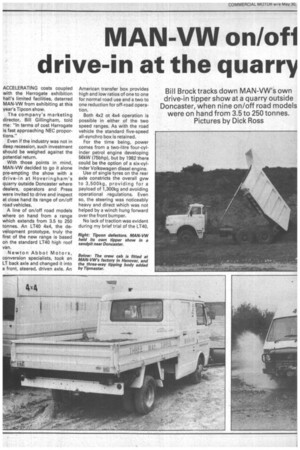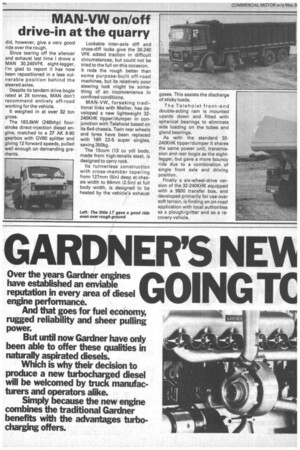MANNW on/ofil
Page 90

Page 91

Page 92

If you've noticed an error in this article please click here to report it so we can fix it.
drive-in at the quarry
ACCELERATING costs coupled with the Harrogate exhibition hall's limited facilities, deterred MAN-VW from exhibiting at this year's Tipcon show.
The company's marketing director, Bill Gillingham, told me: "In terms of cost Harrogate is fast approaching NEC proportions."
Even if the industry was not in deep recession, such investment should be weighed against the potential return.
With those points in mind, MAN-VW decided to go it alone pre-empting the show with a drive-in at Hoveringham's quarry outside Doncaster where dealers, operators and Press were invited to drive and inspect at close hand its range of on/off road vehicles.
A line of on/off road models where on hand from a range which extends from 3.5 to 250 tonnes. An LT40 4x4, the development prototype, truly the first of the new range is based on the standard LT40 high roof van.
Newton Abbot Motors, conversion specialists, took an LT back axle and changed it into a front, steered, driven axle. An American transfer box provides high and low ratios of one to one for normal road use and a two to one reduction for off-road operation.
Both 4x2 ot 4x4 operation is possible in either of the two speed ranges. As with the road vehicle the standard five-speed all-synchro box is retained.
For the time being, power comes from a two-litre four-cylinder petrol engine developing 56kW (75bhp), but by 1982 there could be the option of a six-cylinder Volkswagen diesel engine.
Use of single tyres on the rear axle constricts the overall gvw to 3,500kg, providing for a payload of 1,300kg and avoiding operational -regulations. Even so, the steering was noticeably heavy and direct which was not helped by a winch hung forward over the front bumper.
No lack of traction was evident during my brief trial of the LT40, which, combined with its exceptionally useful square profile, will undoubtedly secure a place in this limited market when the 4 x 4 become available at the end of June.
Lack of power could never be a criticism levelled at MAN's 4x4 plated for 16 tons gvw as it has a power-to-weight ratio of 11kW/tonne (15bhp)ton), provided by a MAN M-type engine.
The 183.6kW (246bhp) unit, located below a bonnet which tips forward for access, drives through a ZF AK 6-90 synchromesh six-speed gearbox.
A G801 two-speed transfer box ensures permanent fourwheel-drive and a third diff links front and rear axles. Both axles employ planetary final drives, allowing small axle housings for maximum ground clearance.
The small three-way tipping body from Meiller will have a very limited attraction for UK operators. At 16 tons the 4x4 provides an alternative to the Unimog and over very rough terrain, driven with restraint, gave a comfortable ride. Allowing for its application i a drawbar configuration at 2 ton gtw and its cross-country pi tential, demand for this spec fication must be small.
Weighing in at 7.5 ton, th MAN-VW MT 8.136 comes wit four wheelbase option: Outwardly, the cab is similar t the LT van range, but mounte higher on the chassis it has a fli floor pan, making room for double passenger seat.
The combination of a fivi speed synchromesh gearbo and its MAN six-in-line diesel er gine gives a lively performance.
Although a little bouncy ovE extremely rought terrain, it rod much better over rough road.
Use of a cab from the va range has scored over using th more normal choice of a scale down version from a 16-tonnE model.
Equipped with a woode dropside tipping body from Dei went Coachworks of York, th vehicle's overall size is likely t appeal to all non-hgv operator and drivers.
Three-way tipping was a fez tu re of VW's LT35 equipped wit a factory fitted crew cab. Thi obviates payment of car tax b leaving out the side windows bE hind the driving seat.
Body and tipping gear hay, been developed by Tipmastei
An electro-hydraulic power pac located inside the LT35's cal operates a four-stage centre lit ram, while tipping direction i controlled by the position of twi spring-loaded bolts.
With a chassis cab unlade' weight of some 305kg less thai the LT35s, the LT31 gives slightly better body/payloai capacity of 2,125kg.
As with all the MAN-VV vehicles I drove at this "private' show, I found the clutch peda positioned much too high abovi the floor. With some it was no possible to operate the clutcl with a straight leg push becausi of space restrictions below thi steering wheel.
Instrumentation is kept to thi essentials on LT models but fol lows the same basic styling o the more generous MT models An engine hump restricts cross cab movement and obstructs thi second and fourth gate posi tions.
The LT's battery is locate( within the cab which, because o the possibility of gassing, is no the ideal place for it.
For a vehicle which has an off road application, there is alsc the possibility of spillage. Fittec here with a Tipmaster body i did, however, give a very good ride over the rough.
Since tearing off the silencer and exhaust last time I drove a MAN 30.240VFK eight-legger, I'm glad to report it has now been repositioned in a less vulnerable position behind the steered axles.
Despite its tandem drive bogie rated at 26 tonnes, MAN don't recommend entirely off-road working for the vehicle.
It weighed in at over 32 ton gross.
The 183.6kW (246bhp) fourstroke direct-injection diesel engine, matched to a ZF AK 6-90 gearbox with GV60 splitter and giving 12 forward speeds, pulled well enough on demanding gradients. Lockable inter-axle diff and cross-diff locks give the 30.240 VFK added traction in difficult circumstances, but could not be tried to the full on this occasion. It rode the rough better than some purpose-built off-road machines, but its relatively poor steering lock might be something of an inconvenience in confined conditions.
MAN-VW, forsaking traditional links with Meiller, has developed a new lightweight 32240KHK tipper/dumper in conjunction with Telehoist based on its 6x4 chassis. Twin rear wheels and tyres have been replaced with 18R 22-5 super singles, saving 350kg.
The 10cum (13 cu yd) body, made from high-tensile steel, is designed to carry rock.
Its runnerless construction with cross-member tapering from 127mm (5in) deep at chassis width to 64mm (2.5in) at full body width, is designed to be heated by the vehicle's exhaust gases. This assists the discharge of sticky loads.
The Telehoist front-end double-acting ram is mounted upside down and fitted with spherical bearings to eliminate side loading on the tubes and gland bearings.
As with the standard 32240KHK tipper/dumper it shares the same power unit, transmission and rear bogie as the eightlegger, but gave a more bouncy ride due to a combination of single front axle and driving position.
Finally a six-wheel-drive version of the 32-240KHK equipped with a 9800 transfer box, and developed primarily for use over soft terrain, is finding an on-road application with local authorities as a plough/gritter and as a recovery vehicle.
































































































































